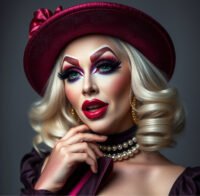Drag vs. Crossdressing: Understanding the Differences and Celebrating Both
By Jenn der Bentson
 The world of gender expression is vast and diverse, encompassing many different identities, styles, and cultures. Two terms that are often misunderstood or conflated are “drag” and “crossdressing.” While both involve individuals presenting as a gender different from their assigned one at birth, they stem from distinct cultures, motivations, histories and many times desires.
The world of gender expression is vast and diverse, encompassing many different identities, styles, and cultures. Two terms that are often misunderstood or conflated are “drag” and “crossdressing.” While both involve individuals presenting as a gender different from their assigned one at birth, they stem from distinct cultures, motivations, histories and many times desires.
The Art of Drag: Performance, Persona, and Expression
Drag is a performance art where individuals, often men, exaggerate femininity (or masculinity, in the case of drag kings) through elaborate clothing, makeup, and personas. Drag is rooted in entertainment and theatricality, with participants commonly performing in clubs, competitions, and on stage.
Drag has been a part of performance culture for centuries. In Shakespearean times, when women were banned from the stage, men would take on female roles, inadvertently creating one of the earliest forms of drag. Over time, drag evolved, particularly within LGBTQ+ communities, as a form of self-expression, satire, and rebellion against societal norms.
Modern drag has gained mainstream attention. Today, drag is a major facet of pop culture, influencing fashion, music, and even politics. Drag queens and kings challenge traditional ideas of gender, using performance to celebrate and subvert these norms.
Some of the key aspects of drag include that it is a performance and for entertainment purposes. It commonly includes theatrical aspects, involving lip-syncing, comedy, dance, and extravagant costuming. Many drag performers develop a distinct stage persona separate from their everyday selves. Drag often involves hyper-feminized or hyper-masculinized looks, playing with exaggerated makeup, wigs, and costumes. Drag culture thrives in communal settings such as clubs, ballroom culture, and television competitions.
Many drag performers do not identify as transgender or live in their drag personas full-time; it is an art form and career for them. Usually this is a persona separate from the performer’s daily life
Crossdressing can be a little different for many.
Crossdressing: Personal Expression, Comfort, and Identity
Crossdressing, on the other hand, is a broad term that refers to individuals who wear clothing traditionally associated with the opposite gender. Unlike drag, crossdressing is not inherently tied to performance or entertainment but is instead often a personal or lifestyle choice. Many crossdressers dress in clothing of another gender for reasons related to self-expression, comfort, or identity rather than as an art form.
Throughout history, crossdressing has existed in many cultures, sometimes for necessity and sometimes for self-expression. Women have historically dressed as men to access male-dominated spaces, such as the military or the workforce. Meanwhile, men who crossdress have done so for a variety of reasons, from personal enjoyment to gender exploration.
The term “crossdresser” gained more visibility in the 20th century, often used by heterosexual men who enjoy wearing women’s clothing but do not identify as transgender or drag performers. Organizations like Tri-Ess (The Society for the Second Self) formed to provide support and community to crossdressers and their families
Compared with drag, many crossdressers dress for personal fulfillment rather than performance. Unlike drag, which is theatrical, crossdressers often aim for a natural or blended look. Crossdressing does not necessarily indicate a specific sexual preference; many crossdressers are heterosexual. Many crossdressers dress privately, while others do so in public, depending on comfort and social acceptance. It is frequently done more private, with smaller support groups or online communities
While drag is often a career or hobby, crossdressing is frequently a long-term, life-spanning personal journey. It is often a personal and deeply ingrained part of someone’s identity
Overlapping Aspects and Shared Experiences
While drag and crossdressing are different, there are areas where they overlap. Both challenge gender norms and push the boundaries of traditional fashion. Some crossdressers explore drag as a creative outlet, and some drag performers may also crossdress in their personal lives. Additionally, both groups can face societal stigma, though the mainstream acceptance of drag has grown significantly in recent years.
It’s also important to recognize that neither drag nor crossdressing is inherently tied to being transgender, though there can be some overlap. Some individuals begin as crossdressers or drag performers and later realize they identify as transgender, but this is not the case for everyone.
One of the biggest misconceptions is that crossdressers and drag performers are the same or that one inevitably leads to the other. This misunderstanding can lead to stereotypes that do not reflect the reality of individual experiences.
Respecting both cultures means recognizing their unique histories and purposes. Whether someone is donning a wig and heels for a drag show or dressing in clothing that aligns with their inner sense of self, their choice is valid and should be embraced. Avoiding assumptions about why someone presents the way they do is crucial to fostering a more accepting and inclusive society.
Both drag and crossdressing celebrate gender expression in different ways. Drag pushes boundaries and challenges societal expectations through performance, while crossdressing allows individuals to explore personal identity and comfort in their own way. Both deserve appreciation and understanding without conflation.

Comments
Drag vs. Crossdressing: Understanding the Differences and Celebrating Both — No Comments
HTML tags allowed in your comment: <a href="" title=""> <abbr title=""> <acronym title=""> <b> <blockquote cite=""> <cite> <code> <del datetime=""> <em> <i> <q cite=""> <s> <strike> <strong>